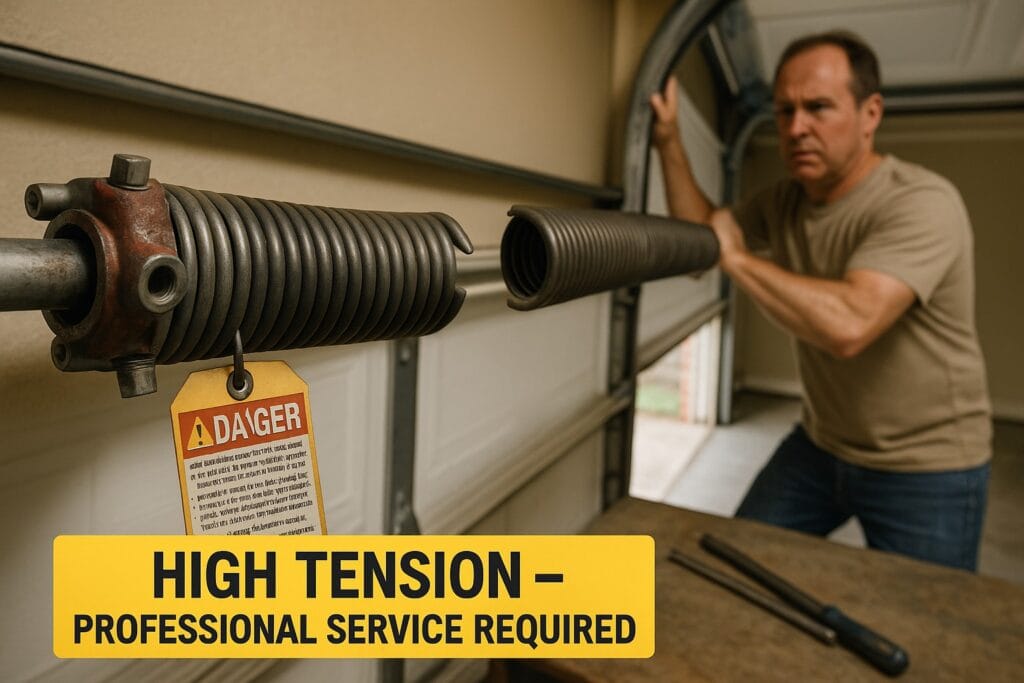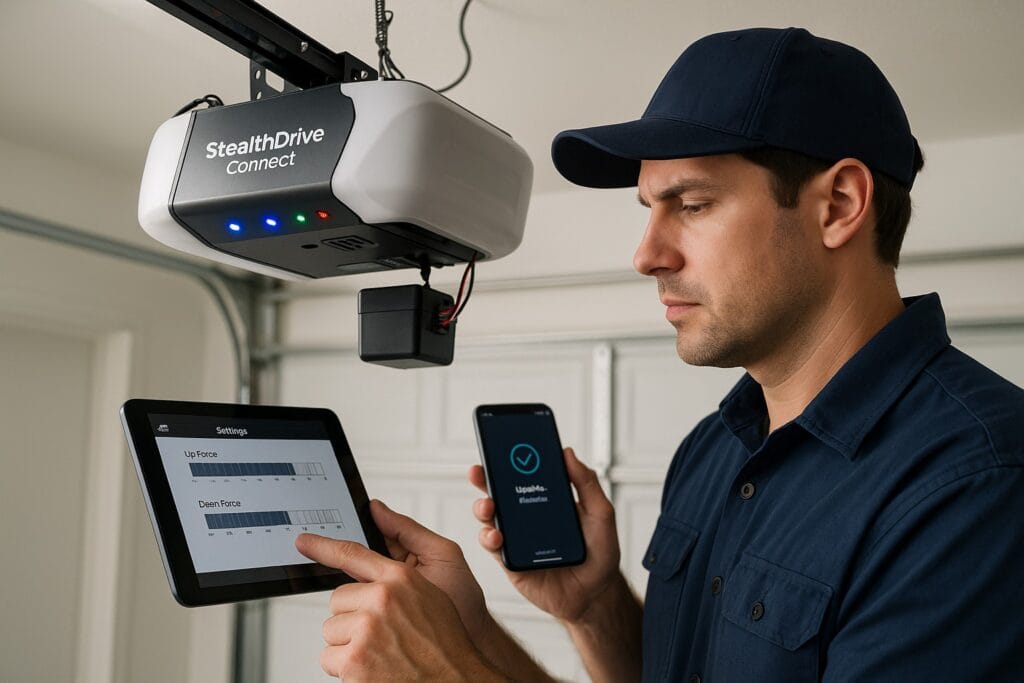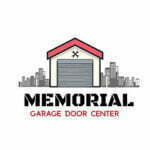The Hidden Dangers of DIY New Garage Door Installation Projects

Why DIY Garage Door Installation Can Be Risky
Earlier this year, a homeowner in Houston contacted us after a failed DIY garage door installation attempt. While trying to secure the torsion springs, the spring released with force, damaging the ceiling and narrowly missing the homeowner. Their garage door hung off its track, the automatic opener was unresponsive, and the top panel was bent. This kind of danger isn’t just inconvenient; it can be life-threatening.
According to the U.S. Consumer Product Safety Commission, garage doors cause over 20,000 injuries annually. Most of these come from poor maintenance, lack of proper safety features, or DIY installations gone wrong. Many homeowners underestimate the complexity and power of garage door systems, believing that with a few tools and an online video, they can handle the job themselves.
At Memorial Garage Door Center, we prioritize safe, efficient, and long-lasting service. Our technicians understand the vital role garage door maintenance plays in protecting your home and family. Whether it’s regular servicing, part replacements, or a full installation, entrusting the work to professionals ensures your system operates with quiet precision and reliability. This also extends the lifespan of your garage door and prevents costly emergency repairs.
Why Garage Doors Aren’t Simple DIY Projects
The Weight and Force Behind the Door
Garage doors, especially double or insulated steel ones, can weigh between 130 to over 400 pounds. Lifting and maneuvering them during installation requires not only strength but also balance and understanding of force dynamics. A poorly aligned door can fall, injure someone, or destroy nearby property.
Components such as torsion springs, cables, rollers, and tracks are engineered to work in unison. If the torsion spring isn’t properly wound or if the cable isn’t secured to the bottom bracket correctly, the system can fail multiple times during operation. An unstable or poorly balanced door can cause excess strain on your garage door opener, eventually leading to burnout or failure.

Not Just About Bolting Parts Together
Installing a garage door isn’t as easy as attaching panels with a socket wrench and calling it a day. It involves:
- Mounting the top rail to the ceiling joists
- Securing the track system and ensuring it’s level and plumb
- Installing rollers and hinges with precision
- Attaching the arm bar to the garage door opener
- Programming the auto-reverse feature for safety compliance
- Aligning photo-eye sensors to prevent accidental closures
- Ensuring weatherstripping is properly sealed to block out water and debris
All these steps must be executed with precision and experience. Missing even one can compromise the entire system.
The Real Hazards Hidden in DIY Installation
Torsion Springs: A Loaded Weapon
Garage door springs store a massive amount of energy. The moment they’re installed or adjusted improperly, they can snap with enough force to break bones or cause deep lacerations. Torsion springs especially require winding bars—not just any tool will do. Improvised tools can slip or fail under pressure.
In many cases, homeowners assume the tension is manageable, only to have the spring snap or unwind rapidly. This can destroy parts of the garage door system, damage the garage ceiling, and injure those nearby. Broken torsion springs can even snap the center bearing plate or cause the shaft to twist, leading to more expensive repairs.
Electrical and Fire Risks
When connecting the garage door opener, handling wiring incorrectly can lead to:
- Short circuits
- Fire hazards
- Inoperable automatic openers
- Burnt-out motors
- Tripped breakers or faulty safety sensors
Additionally, failing to set up the safety sensors can result in a lack of protection for pets and children. If the door doesn’t reverse when something is in the way, you’re putting your family at risk. Loose wiring and incorrect grounding can also interfere with smart features like Stealth Drive Connect or voice control systems.
No Warranty Coverage
Many garage door manufacturers void the warranty if the product is not installed by a certified professional. That means if a roller bracket breaks or a panel warps, you’ll be responsible for replacement costs. You may also find it difficult to source compatible replacement parts, and the lack of documentation on DIY installations can create problems during insurance claims or home inspections.
Importance of Regular Garage Door Maintenance
Even a perfectly installed door will suffer if not maintained. Over time, moving parts like rollers, hinges, and springs wear down. Dust, debris, and weather changes accelerate this process, especially in climates with high humidity or temperature swings like Houston.
What Regular Maintenance Involves
- Lubricating metal parts: Use white lithium grease or spray lubricants on garage door rollers, springs, cables, and hinges for quiet operation.
- Inspecting garage door tracks: Clear out debris, ensure proper alignment, and check for rust spots.
- Testing the auto-reverse feature: Place a small object in the door’s path to confirm the sensor works. This simple test can prevent tragic accidents.
- Tightening bolts and screws: Over time, vibration loosens critical components. Use a socket wrench to ensure all fasteners remain secure.
- Checking weatherstripping: Prevents water damage, improves insulation, and blocks dirt and pests.
- Cleaning and vacuuming tracks: Dirt buildup causes friction that wears down rollers and affects the balance of the system.
A family handyman might do some of these tasks periodically, but a professional offers a full safety and performance inspection that includes balance testing, opener diagnostics, and proactive recommendations.
Real Cases of DIY Garage Door Fails
Case 1: Broken Cable and Roller Misalignment
A homeowner in Spring, TX, attempted to install a new garage door and didn’t realize one of the cables had unraveled from the drum. They kept operating the garage door opener, which pulled unevenly on one side. After a week, the roller brackets snapped, and the door caved in.
Repair cost: $2,500 and replacement of door panels and cables. They also had to replace the opener, which had burned out from the imbalance.
Case 2: Power Issues and Wiring Failure
In The Heights, a homeowner wired their stealth drive connect opener incorrectly. The opener turned on once, then stopped responding. The reversed polarity damaged the circuit board. Worse, the garage light fixture shorted out and required additional electrical repairs.
Repair cost: $450 and a new opener system, plus an electrician’s visit.
Case 3: Hinges and Springs Disaster
A DIYer from Pasadena installed the door but didn’t secure the garage door hinges properly. The door opened halfway and got stuck. They tried to force it up manually, causing a torsion spring to snap.
Repair cost: $1,800 including spring replacement, roller reset, and sensor alignment. Their insurance claim was denied due to unauthorized modifications.
What You Need for Proper Installation
Tools of the Trade
Professionals come equipped with:
- Winding bars for spring setup
- Laser levels to align tracks and ensure level mounting
- Impact drills, socket wrenches, and torque-specific tools
- Spray lubricants for moving metal parts
- Ladders, support jigs, and scaffolding for overhead work
- Garage door lubricant specifically designed to reduce wear and corrosion
Without these, installation becomes a guessing game with potentially disastrous results.
Professional Know-How
Experienced technicians are trained in:
- Garage door spring calibration based on door weight and usage
- Safety feature programming, such as setting the correct force and speed for door openers
- Weather-resistant sealing to protect against rain, wind, and humidity
- Smooth operation testing to ensure no component is under strain
- Advanced troubleshooting for opener logic boards, remote sync issues, and travel limit settings
They understand how each component affects the whole system and can detect problems before they become expensive repairs.
What seems like a $600 saving can actually cost you thousands. Here’s why:
- Medical bills for injuries from mishandled parts or ladders
- Re-purchase of damaged garage door parts (panels, rollers, hinges)
- Tool rental costs that add up for each specialized tool
- Corrective services that include uninstalling and reinstalling the door properly
- Insurance denials due to unauthorized modifications
- Time lost during failed attempts or multiple do-overs
DIY may seem like a weekend project, but it can quickly become a multi-week headache.
Smart Features at Risk with Improper Installation
Modern garage door openers come with smart tech, including:
- App control via smartphone
- Auto-close timers and scheduling
- Voice assistant integration (e.g., Alexa or Google Home)
- Security camera syncing for real-time monitoring
- Battery backup systems for power outages
A faulty install can interfere with:
- Wi-Fi signals
- Power supply to connected devices
- Auto-reverse malfunctions
- Remote syncing or mobile app errors

Smart garage door systems offer convenience and security, but only when installed correctly and maintained regularly.
Safer, Smarter Alternatives to DIY
If you’re budget-conscious, here’s how to stay safe:
- Hire a local professional: Get a quote from a reputable provider like us with transparent pricing.
- Use standard door models: They cost less, are readily available, and easier to maintain.
- Choose a maintenance package: Includes installation, adjustment, and routine inspections to keep your system running for years.
- Schedule yearly inspections: Prevention is cheaper than repair.
- Educate your family: Teach proper use of the opener, emergency release, and manual lift protocols.
What to Look for in a Garage Door Installer
Avoid these red flags:
- No verifiable address or business license
- Incomplete quotes or vague timelines
- No warranty or guarantee on labor or parts
- Unlicensed or uninsured status
- Poor online reviews or limited service history
At Memorial Garage Door Center, we check all the right boxes:
- Local team based in Houston, TX
- Licensed and insured professionals
- Transparent, upfront pricing
- 5-star reviews from your neighbors
- Ongoing service and customer support
Final Thoughts: Keep Your Family Safe with Pro Installation
Your garage door isn’t just a moving wall, it’s part of your home’s first line of defense. It guards your car, tools, and in many homes, acts as the main entrance. A poorly installed system puts your family and property at risk. More importantly, it puts the very safety of those in and around your home in jeopardy every time the door is used.
Instead of gambling on a DIY fix, invest in safety, reliability, and professional garage door maintenance. With professional help, you ensure:
- Smooth, quiet operation for years
- Optimized performance across all seasons
- Peace of mind every time you hit that remote
- Adherence to safety standards and building codes
- Reliable functionality of smart features and backup systems
Don’t compromise your home’s security or your family’s safety. Choose peace of mind. Choose professionalism.
How Can McKinney Garage Door Repair Co. Help You?
When you need expert care, fast service, and a trustworthy local team, call McKinney Garage Door Repair Co. We specialize in:
- New garage door installations (steel, wood, composite, and more)
- Full garage door maintenance and tune-ups
- Repair of garage door springs, rollers, openers, and tracks
- Smart opener upgrades and safety sensor setups
- Weather seal installations and preventative maintenance
- Rust removal and corrosion protection
We proudly serve Houston, TX, and all surrounding neighborhoods.
📍 Address: 1312 Utah St, Houston, TX 77007, United States
📞 Phone: (281) 720-3113
Whether your garage door needs urgent attention or just routine care, our certified technicians are here to help. Contact us today and experience reliable, efficient, and safe garage door service, done right the first time.
If you’d like this article formatted for your website, turned into a downloadable guide, or adapted for a service page, let me know!
Frequently Asked Questions (FAQs)
1. How long does it typically take to professionally install a garage door?
Most standard garage door installations take between 4 to 6 hours when done by trained professionals.
2. Can I reuse old tracks and rollers when replacing my garage door?
It’s not recommended, as old tracks and rollers may not be compatible with new doors and can lead to poor performance or safety issues.
3. How do I know if my garage door needs lubrication or professional maintenance?
If your door makes grinding noises, opens unevenly, or jerks during movement, it likely needs lubrication or servicing.
4. Are insulated garage doors worth the investment for Houston homes?
Yes, insulated garage doors help regulate indoor temperatures, reduce noise, and offer better durability in Houston’s humid climate.
